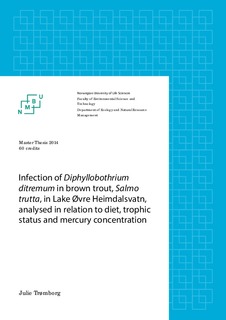| dc.description.abstract | There have been profound alternations in the parasite fauna of brown trout in the
subalpine lake Øvre Heimdalsvatn, since the first survey of the parasite fauna was
conducted in 1969 - 71. One of the most prominent changes is the strong increase in
infection of Diphyllobothrium ditremum. Accordingly the main objective of this study was
to examine the cause and effect of the increased infection of D. ditremum in brown trout
by looking at differences in feeding behaviour and parasite distribution. Since infection
in brown trout with plerocercoids of D. ditremum may be caused by both feeding on
infected copepods and by feeding on infected conspecifics, the diet of brown trout was
studied with the aim of assessing the independent role of each of the two food items in
transferring D. ditremum to the brown trout population. This was conducted by studying
infection of D. ditremum, together with stomach content analysis, analyses of stable
isotopes of nitrogen and carbon, as well as mercury concentrations in brown trout from
Ø. Heimdalsvatn.
The results strongly suggests that copepods constitute the main source of D. ditremum to
the brown trout population as there were no clear correlation between the trophic level
of brown trout and the intensity of D. ditremum. Both prey items, however, constituted a
small amount of the diet of the trout investigated. Even so, it is likely that there has been
an increase in the proportion of infected copepods in the diet of brown trout following
an increased number of birds, functioning as final hosts for D. ditremum, foraging in the
lake. The increased number of final hosts will lead to a higher output of D. ditremum eggs
into the water, most likely leading to a larger proportion of the copepod population
being infected, thus increasing the number of D. ditremum larvae being transferred to
the brown trout, when copepods are fed upon. Brown trout males had higher probability
of being infected with D. ditremum and had higher intensity than females. This is most
likely a result of males utilizing the near shore habitats to a greater extent than females.
These areas have presumably higher proportion of infected copepods due uneven
foraging activity of the final host.
Thus, European minnow seem to be the indirect reason for the increased infection of D.
ditremum in brown trout in Lake Øvre Heimdalsvatn, by forming a larger food base for
the final hosts.
Despite the substantial increase in infection, there were no clear signs of brown trout
mortality caused by plerocercoids of D. ditremum in the present study.
Det har skjedd store endringer i parasittfaunaen til brunørret i Øvre Heimdalsvatn siden
parasittfaunaen for første gang ble undersøkt i 1969-71. En av de mest utpregede
endringene er den store økningen i infeksjon av fiskandmakk. Følgelig har
hovedformålet med oppgaven vært å undersøke årsak og virkning av økt
fiskandmakkinfeksjon i brunørret, ved å se på ulikheter i diett og fordelingen av
parasitten i brunørretpopulasjonen. Parasitten kan overføres til brunørret ved inntak av
både infisert hoppekreps og infisert småørret. Dietten til brunørret har dermed blitt
undersøkt ved hjelp av mageanalyser, analyser av stabile isotoper av nitrogen og karbon
så vell som kvikksølvkonsentrasjon, for å undersøke byttedyrenes rolle i overføring av
D.ditremum til brunørretpopulasjonen.
I følge resultatene er det sannsynlig at hoppekreps utgjør hovedkilden til fiskandmakk i
brunørret ettersom det ikke var noen klar sammenheng mellom trofisk nivå og antall
parasitter. Både småørret og hoppekreps utgjorde en liten del av dietten til brunørreten.
Det er allikevel sannsynlig at det har skjedd en økning i mengden infiserte hoppekreps i
dietten som følge av en økning i antall fiskespisende fugl ved vannet. Disse utgjør den
endelige verten for parasitten og vil føre til at det slippes ut flere fiskandmakkegg i
vannet nå enn tidligere. Dette har mest sannsynlig ført til at en større andel av
hoppekrepspopulasjonen er blitt infisert, hvilket fører til at mer fiskandmakk vil
overføres til brunørret i de tilfellene hvor brunørreten spiser hoppekreps.
Hannørret hadde større sannsynlighet for å være infisert med fiskandmakk og hadde
større intensitet av parasitten enn hunnørret. Dette skyldes trolig at hannørret bruker
de strandnære områdene i en større grad. Disse områdene har sannsynligvis en større
konsentrasjon av infiserte hoppekreps enn andre deler av innsjøen som følge av ujevn
aktivitet hos den endelige verten.
Den store økningen av fiskandmakk i brunørret i Øvre Heimdalsvatn ser ut til å være
indirekte grunnet etableringen av den fremmede arten ørekyt, ved at den skaper et
større næringsgrunnlag for de endelige vertene.
Til tross for den betydelige økningen i infeksjon av fiskandmakk, var det ingen tydelige
indikasjoner på dødelighet hos brunørret som følge av parasitten. | nb_NO |
